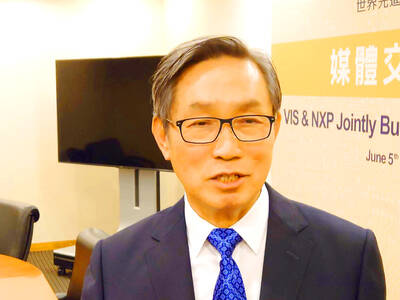The equity market was expected to experience sustained rising impetus this week, backed by anticipations of strong sales by high-tech exporters and continuous robust capital momentum after weeks of buying sprees.
Yet, the limited upside after a long rally and possible downturn of stocks that has reported less ideal profits for the first half could become investment uncertainties, analysts said.
"The TAIEX could continue to strengthen to the 9,700 mark, while seeing support at 9,200 [this week]," an equity research team of IBT Securities Co (台灣工銀證券) said in a report released over the weekend.
The high-tech industry's traditional high season began earlier than before, which would greatly benefit local electronics makers, the team said, citing the US National Retail Federation's forecast of a record 13 percent increase in demand for electronics goods in the US' back-to-school sales in September.
Foreign investors' continued buying, favorable government policies, plus estimated payout of a combined NT$800 billion (US$24.4 billion) in dividends by listed firms, would collectively contribute to a bull market in the local stock exchange, the report said.
The TAIEX gained 112.59 points, or 1.17 percent, to close at 9,585.90 on Friday on turnover of NT$221.92 billion, marking a new seven-year high in the wake of 10 straight weeks of advance.
However, a plunge in the US stocks on Friday, with the Dow Jones Industrial Average losing more than 149 points, or 0.4 percent to close at 13,851.08, could cast uncertainty on Taiwan's markets when they open today.
Investors may need to be more cautious as the TAIEX could see shrinking short-term upside or consolidation following a long surge, IBT Securities said, adding that buyers should avoid companies that did not report bright sales during the first six months of this year.
Henry King (金文衡), head of Taiwan equity research with Goldman Sachs, said last week that the industry fundamental and liquidity momentum remain healthy in the current quarter, but the risk of a correction was rising following the 15-percent jump in the TAIEX over the past month.
He appeared cautious about the market outlook for fourth quarter, citing several factors which could dilute profitability per share, including vendors' overdue optimism without considering consumers' budget constraint, buyers' holding back before rollout of new products, possible inventory pileup and the implementation of employee bonuses next year to dilute profitability per share.
Despite the fact that some analysts are positive that the TAIEX could hit 10,000 points during the current quarter, King said picking the right stocks was more important than the surge scale of the index.
Goldman Sachs recommended nine high-tech stocks, including Compal Electronics Inc (
It also liked Chinatrust Financial Holding Co (中信金控) and Chang Hwa Bank (彰化銀行) on a merger and acquisition story, and insurance stocks on strong core business growth and contribution of investment return to their bottom lines.
In the non-tech sphere, Macquarie Securities said last week that they prefer President Chain Store Corp (

TARIFFS: The global ‘panic atmosphere remains strong,’ and foreign investors have continued to sell their holdings since the start of the year, the Ministry of Finance said The government yesterday authorized the activation of its NT$500 billion (US$15.15 billion) National Stabilization Fund (NSF) to prop up the local stock market after two days of sharp falls in reaction to US President Donald Trump’s new import tariffs. The Ministry of Finance said in a statement after the market close that the steering committee of the fund had been given the go-ahead to intervene in the market to bolster Taiwanese shares in a time of crisis. The fund has been authorized to use its assets “to carry out market stabilization tasks as appropriate to maintain the stability of Taiwan’s

STEEP DECLINE: Yesterday’s drop was the third-steepest in its history, the steepest being Monday’s drop in the wake of the tariff announcement on Wednesday last week Taiwanese stocks continued their heavy sell-off yesterday, as concerns over US tariffs and unwinding of leveraged bets weighed on the market. The benchmark TAIEX plunged 1,068.19 points, or 5.79 percent, to 17,391.76, notching the biggest drop among Asian peers as it hit a 15-month low. The decline came even after the government on late Tuesday authorized the NT$500 billion (US$15.2 billion) National Stabilization Fund (國安基金) to step in to buoy the market amid investors’ worries over tariffs imposed by US President Donald Trump. Yesterday’s decline was the third-steepest in its history, trailing only the declines of 2,065.87 points on Monday and

TARIFF CONCERNS: The chipmaker cited global uncertainty from US tariffs and a weakening economic outlook, but said its Singapore expansion remains on track Vanguard International Semiconductor Corp (世界先進), a foundry service provider specializing in producing power management and display driver chips, yesterday withdrew its full-year revenue projection of moderate growth for this year, as escalating US tariff tensions raised uncertainty and concern about a potential economic recession. The Hsinchu-based chipmaker in February said revenues this year would grow mildly from last year based on improving supply chain inventory levels and market demand. At the time, it also anticipated gradual quarter revenue growth. However, the US’ sweeping tariff policy has upended the industry’s supply chains and weakened economic prospects for the world economy, it said. “Now

An employment discrimination lawsuit against contract chipmaker Taiwan Semiconductor Manufacturing Co (TSMC, 台積電) might soon be expanded after a hearing in a federal court in San Jose, California, on Tuesday to add 15 plaintiffs to the case. According to a court document, the lawsuit, which was refiled in November last year as a form of a class action with 13 plaintiffs in California, wants to add 15 plaintiffs from Arizona, where TSMC is building up its wafer fab capacity. TSMC first committed between 2020 and last year to invest US$65 billion in three advanced wafer fabs in Arizona. It then pledged an